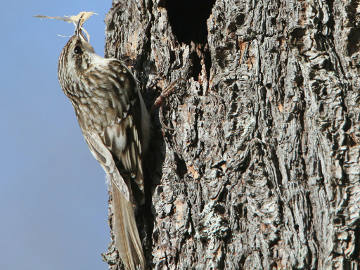Village News

PHOTO COURTESY OF GARRY KESSLER
A brown creeper.
July 19, 2019, Page A9
NATURE NOTES
By Annie Reid
Westborough Community Land Trust
Brown creepers on bark
When you hear the word “creeper,” what comes to mind? Many of us think first of pesky wild vines that volunteer in our gardens and yards, such as Virginia Creeper (Parthenocissus quinquefolia) or invasive Asian bittersweet (Celastrus orbiculatus). But think again, there’s also a little brown bird that travels tree trunks, known as a brown creeper.
Brown creepers (Certhia americana) aren’t easy to notice, but they’re found year-round in our area. They’re so well camouflaged against tree trunks that they’ve been famously likened to a piece of bark come to life. They’re a treat to see.
Bark provides both food and shelter to these little birds. They hunt insects, spiders, and insect eggs and larvae on tree trunks and large branches. Brown creepers live where trees are older and larger – about a foot in diameter or more. Why? Such trees usually have thicker bark with more creases, cracks, and crevices where insects live.
Bark, especially loose bark, is crucial to brown creepers in the nesting season. A pair builds its nest behind loose bark, against the tree trunk. The well-hidden nest is shaped like a hammock or crescent. To find slabs of loose bark, brown creepers seek out dead trees or dead parts of living trees. They often find what they need in swamps and other areas near water, so look for them there.
To spot a brown creeper while you’re out on the trails, watch for their typical behavior, especially if you’re near water. Brown creepers start at the bottom of a tree trunk and hop upward, spiraling around the tree as they search for food. Then they fly down to the base of another nearby tree trunk and work their way up, and then on to the next, and so on. If you see a bird doing this, you’re probably looking at a brown creeper.
You won’t see a brown creeper going head-first down a tree, the way our nuthatches do. Brown creepers are well outfitted for traveling and hunting on tree trunks. They have long, down-curved bills for probing the bark, sharp curved claws that hook into bark, and stiff tail feathers for bracing themselves during their upward travels and foraging stops.
What about song? Males sing in the spring breeding season (https://www.allaboutbirds.org/guide/Brown_Creeper/sounds), but you won’t hear much from brown creepers during the rest of the year.
In the fall, some brown creepers from farther north move southward through our area, so it can be a good time to keep an eye out for these birds. You might see one traveling with a mixed flock of chickadees, nuthatches, and other local birds. Brown creepers also sometimes come to feeders that provide suet or peanut butter.
The numbers of brown creepers in New England have been increasing in recent years as forests have re-grown and aged. The death of trees from gypsy moths and other blights may actually benefit brown creepers. At the same time, logging and the forest fragmentation that comes with development tend to reduce the habitat that brown creepers favor.